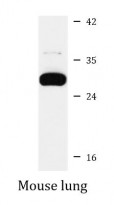ARG58325
anti-CD263 / TRAIL R3 antibody
anti-CD263 / TRAIL R3 antibody for Western blot and Mouse,Rat
Overview
| Product Description | Rabbit Polyclonal antibody recognizes CD263 / TRAIL R3 |
|---|---|
| Tested Reactivity | Ms, Rat |
| Tested Application | WB |
| Host | Rabbit |
| Clonality | Polyclonal |
| Isotype | IgG |
| Target Name | CD263 / TRAIL R3 |
| Antigen Species | Human |
| Immunogen | Recombinant fusion protein corresponding to aa. 30-130 of Human CD263 (NP_003832.2). |
| Conjugation | Un-conjugated |
| Alternate Names | Lymphocyte inhibitor of TRAIL; Antagonist decoy receptor for TRAIL/Apo-2L; TNF-related apoptosis-inducing ligand receptor 3; DCR1; TRID; CD antigen CD263; Tumor necrosis factor receptor superfamily member 10C; CD263; Decoy TRAIL receptor without death domain; LIT; Decoy receptor 1; DcR1; DCR1-TNFR; TRAIL-R3; TRAIL receptor 3; TRAILR3; TRAIL receptor without an intracellular domain |
Application Instructions
| Application Suggestion |
|
||||
|---|---|---|---|---|---|
| Application Note | * The dilutions indicate recommended starting dilutions and the optimal dilutions or concentrations should be determined by the scientist. | ||||
| Positive Control | Mouse lung | ||||
| Observed Size | 27 kDa |
Properties
| Form | Liquid |
|---|---|
| Purification | Affinity purified. |
| Buffer | PBS (pH 7.3), 0.02% Sodium azide and 50% Glycerol. |
| Preservative | 0.02% Sodium azide |
| Stabilizer | 50% Glycerol |
| Storage Instruction | For continuous use, store undiluted antibody at 2-8°C for up to a week. For long-term storage, aliquot and store at -20°C. Storage in frost free freezers is not recommended. Avoid repeated freeze/thaw cycles. Suggest spin the vial prior to opening. The antibody solution should be gently mixed before use. |
| Note | For laboratory research only, not for drug, diagnostic or other use. |
Bioinformation
| Gene Symbol | TNFRSF10C |
|---|---|
| Gene Full Name | tumor necrosis factor receptor superfamily, member 10c, decoy without an intracellular domain |
| Background | The protein encoded by this gene is a member of the TNF-receptor superfamily. This receptor contains an extracellular TRAIL-binding domain and a transmembrane domain, but no cytoplasmic death domain. This receptor is not capable of inducing apoptosis, and is thought to function as an antagonistic receptor that protects cells from TRAIL-induced apoptosis. This gene was found to be a p53-regulated DNA damage-inducible gene. The expression of this gene was detected in many normal tissues but not in most cancer cell lines, which may explain the specific sensitivity of cancer cells to the apoptosis-inducing activity of TRAIL. [provided by RefSeq, Jul 2008] |
| Function | Receptor for the cytotoxic ligand TRAIL. Lacks a cytoplasmic death domain and hence is not capable of inducing apoptosis. May protect cells against TRAIL mediated apoptosis by competing with TRAIL-R1 and R2 for binding to the ligand. [UniProt] |
| Cellular Localization | Cell membrane, GPI-anchor, Lipid-anchor. [UniProt] |
| Calculated MW | 27 kDa |
| PTM | N-glycosylated and O-glycosylated. [UniProt] |
Images (1) Click the Picture to Zoom In






